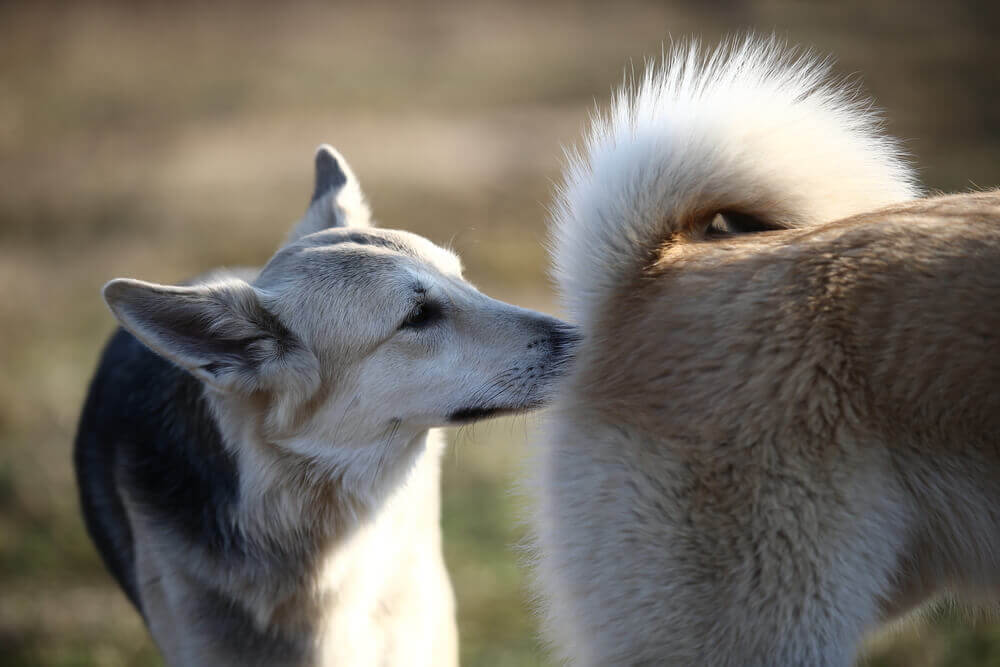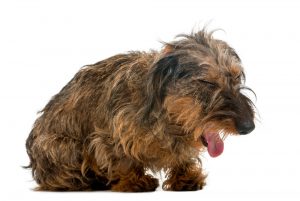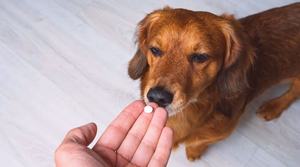Even though it is a perfectly natural - and inevitable - thing for a female dog who has not been spayed to go into heat, it can be a frustrating, and even stressful experience for her human pet parents.
How long does a dog stay in heat? At what age will it first occur? How can pet parents prevent unwanted puppies, health issues and more?
These can be important questions to get an answer to for those dealing with the issue for the first time.
In terms of the answer to the first question, how long does a dog stay in heat, the answer is that the estrus period - when a pup can become pregnant - lasts for five to fourteen days in most dogs. The heat season however is a little more complex than this, and for those pet parents looking for a more complete guide, that's just what we are going to provide here.
At What Age Does a Female Dog Go Into Heat (Estreous Cycle)?
On average, a female dog will go into heat (estrous cycle) for the first time, if not spayed, when she is around six months old and then they experience a new ovarian cycle approximately every 6 months. This is a general average, however. A dog's specific size and breed can alter this timeline.
Generally, smaller dogs mature faster, and it may be a year or more before some large breed pups reach puberty and experience their first heat cycle.
However, pet parents should be prepared for the fact that from the age of six months on, their female dog could go into heat at any time.
How Long Does a Female Dog Stay in Heat?
The answer to this question is a little more complex, and calls for an explanation of the heat cycle in dogs in full, which extends far beyond the 5-14 days the estrus cycle lasts.
In the same way as there are several stages in a dog's pregnancy, 'going into heat' involves four distinct stages, and distinct changes in the body that should be completely understood by pet parents. These can be broken down as follows:
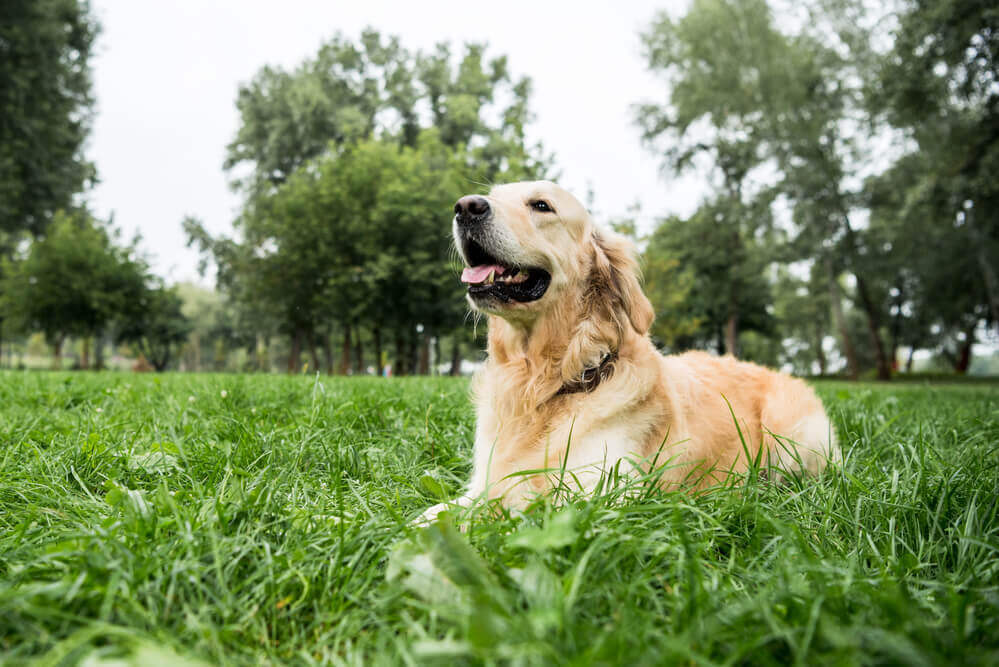
A female Golden Retriever dog in heat.
Proestrus Stage
This is the first stage of the canine heat period. A pup cannot become pregnant at this time. For a period of between seven and ten days, the dog's vulva will be visibly swollen, and she will begin to bleed. Male dogs will be attracted but the female dog will not allow him to mount her.
The proestrus stage lasts an average of 9 days but may range from 0 to 17 days.
Estrus Stage
This is part of the canine heat cycle that pet parents struggle with the most. During this stage, a female dog is fertile and can become pregnant. Her ovaries release eggs and, under the right circumstances, those eggs can be fertilized.
During this time, the female dog will actively try to seek out male company, allow the male to mount her and breed. She will behave in a way that humans might consider flirtatious. She will also be attractive to any male dogs she comes into contact with, and if there are male dogs in your neighborhood who are allowed to roam free - which is not ideal, but some owners allow it - don't be surprised if they end up on your doorstep. Your pup herself may also actively try to escape.
The estrus stage lasts an average of 9 days but may range from 2 to 21 days.
Diestrus Stage
The inset of the diestrus stage signals that a female dog's fertile period is coming to an end. It may last for between 60 and 90 days.
Diestrus is the stage during which successfully bred bitches become pregnant.
If the pup did conceive while in heat, it's at this time that puppies will gestate, a process that usually lasts for around 60-65 days but will, again, vary from pup to pup, according to their age and breed.
During this stage, a milky, odorless discharge may be evident early on in diestrus, but generally, vulvar discharge should cease.
Diestrus lasts around 60 days.
Anestrus Stage
This is the final stage in the female dog's heat cycle and will last for between 100 and 150 days, making it the longest part of the process. During this time, your pup will 'return to normal' and is very unlikely to show any sexual interest in male dogs. After this, the cycle begins again.
Here's a brief overview of estrous cycle with duration, signs and symptoms.
- Stage: Proestrus
- Duration: 9 days
- Signs: Swelling of the vulva, vulvar discharge. Male dogs are attracted to her.
- Stage: Estrus
- Duration: 9 days
- Signs: Softening of the vulva, straw-colored discharge. Males can mount and breed her.
- Stage: Diestrus
- Duration: 60 days
- Signs: Milky odorless discharge early on which then stops, mammary development and lactation. Successfully bred females are pregnant. Some may experience light lethargy. Males no longer interested.
- Stage: Anestrus
- Duration: 100-150 days
- Signs: No physical or behavioral changes.
How Long Does a Dog Stay in Heat for the First Time?
From the first time they experience the heat cycle, a dog will generally follow the same time period pattern as they will for the rest of their fertile life, and the one that we have just described.
In total, when you add up the time taken to progress through all four stages it is a period of around 200 days, but the actual number of days when a female dog can become pregnant during this time is usually less than two weeks.
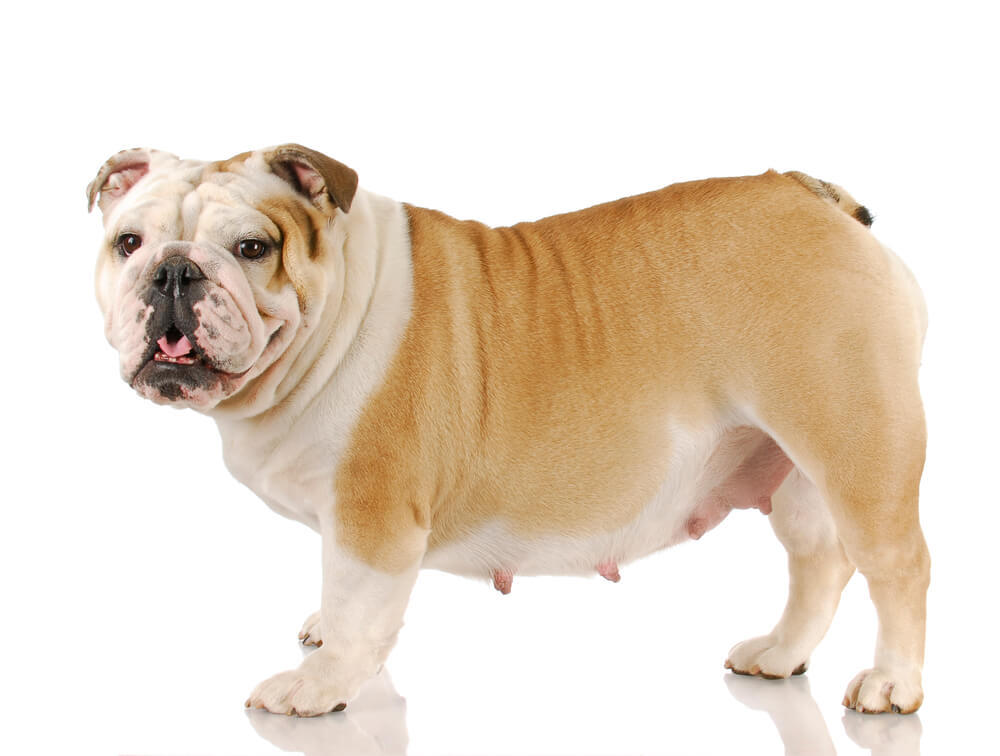
A pregnant English Bulldog
Signs That a Dog is Going Into Heat
If you have a young female dog, you may not know what to look for that signals she is going into heat. Because preventing pregnancy may be important to you, and certainly safeguarding her general health will be, here is a look at some of the signs and 'symptoms' your pup may display that signify she is going into active heat.
Note: By active heat we mean the proestrus and estrus stages as described above. The biggest changes occur during the estrus period, when your pup can actively become pregnant but other things that people associate with a dog being in heat - such as bleeding - actually begin in the proestrus stage.
Physical Signs
- Swelling of the vulva
- Bleeding or spotting from the vulva
- Increased urination
- Increased lethargy
- Increased licking of the genital area
- Slight fever
Behavioral Signs
To determine if your female dog is going into heat, there are also behavioral changes you should watch for:
- Will appear to be behaving what we would call flirtatiously
- May become more affectionate around her human companions
- May 'hump' any other dogs she comes into contact with, male or female
- May become scared or anxious, especially if this is the first time she is experiencing the heat cycle.
How Often is a Dog in Heat?
On average - and it should be noted that there is no such thing as a 'standard' heat timeline, and it may - and will - vary from pup to pup - a female dog will go into active heat twice a year.
Some small breed dogs may go into heat three times, while very large breeds may only experience active heat on an annual basis.
'Predicting' your dog's cycle is a matter of paying attention and tracking the 'signs'.
How Long Does a Dogs Period Last?
As humans, we like to give labels to things that make sense to us, even if they don't really apply.
The human reproductive cycle is very different to the canine one, but because dogs do bleed during the proestrus cycle many pet parents refer to this as a 'dogs period'.
It isn't really, but for those who do use the term the answer would be that, as previously mentioned, the proestrus stage, when bleeding occurs, usually lasts for seven to ten days.
When Will My Puppy Go Into Heat?
Usually, puppies experience their first active heat at around six months of age.
Most vets and breeders do not recommend that dogs be bred during this first cycle however, as the dog is still growing themselves at this point and likely lacks both the physical and mental maturity to handle becoming a 'puppy mom'.
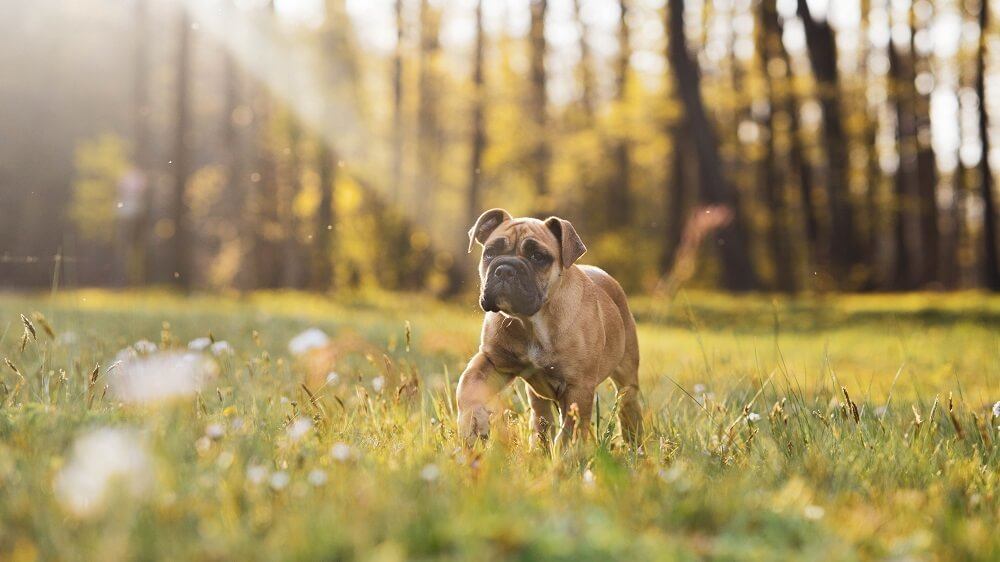
Photo by Anna Dudkova on Unsplash
How Long Does a Puppy Stay in Heat?
A puppy will usually stay in active heat for as long as an adult dog: 7 to ten days in the proestrus stage and then five to fourteen days in the fertile estrus stage.
Why is My Dog Not Going into Heat?
If your dog does not seem to go into heat at what is considered the average time - around six months of age - you may become concerned.
There are a number of possible reasons to consider, including all the following:
They are Not Yet Sexually Mature
As we have stated previously, six months is an average for the first time a dog goes into heat. Female dogs reach puberty at different ages. Some larger breed dogs may not do so, and thus experience their first active heat period until much later, sometimes up to two years old.
Silent Heat Cycles
Some dogs go through heat cycles without displaying any of the typical signs of doing so, including bleeding. Even without these signs they can still become pregnant, so a consult with a vet may be called for to ensure that all is well and their reproductive system is normal.
Malnutrition
Malnourished dogs will often not go into heat. By malnourished we do not mean starving. If a female is not getting enough high quality nutrition it may affect their fertility, and thus their heat cycle. Always make sure you are feeding your pup high quality food that meets all their needs. It's important for their health for lots of reasons, including this one.
Ovarian Hypoplasia
When the ovaries do not fully develop and are unable to produce enough estrogen for your female to have a normal heat cycle, this is known as ovarian failure. The vulva and mammary glands will remain small and underdeveloped. Your vet can diagnose this condition and advise you on how to proceed.
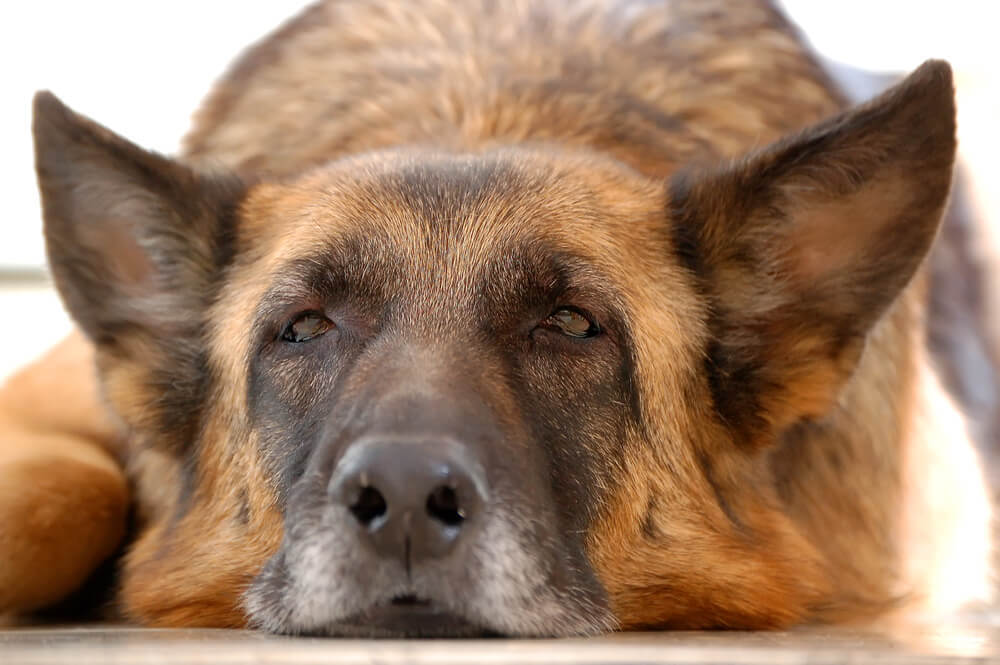
An older female German shepherd dog.
What Age Do Dogs Stop Going Into Heat?
Although an older female dog will often stop displaying signs of going into heat as she ages, the fact is that for a dog, fertility lasts for life.
This means that even a dog considered a senior can become pregnant, even when their pet parent has assumed they would be too old.
As a 'senior pregnancy' can be dangerous for their health, such an event will need to be carefully monitored by your vet.
Can I Prevent My Dog from Going into Heat?
Most pet parents know that having their female pup spayed will be a permanent solution to stop them going into heat. Spaying a female dog involves the removal of the ovaries, so they simply no longer have the ability to reproduce, so won't go into heat.
What many people do not know however is that there are now non-surgical solutions that can prevent a dog going into an active heat and becoming pregnant. Technically it's almost like the pill for dogs.
If you want to stop heat cycles but plan on breeding the dog later, or if a medical condition or circumstance prevents your vet from performing a spay, as soon as signs of proestrus appear, a drug called megestrol acetate can be administered orally. It is administered for eight days in a row in order to break the heat cycle.
However, this is very much hit-and-miss in many cases, as a dog's proestrus is hard to predict, and you may miss the 'window of opportunity' to prevent active heat.
The drug also has known risks and side effects, but if this is something you are interested in it can be discussed with your vet, who will need to be in charge of the process if you go ahead.
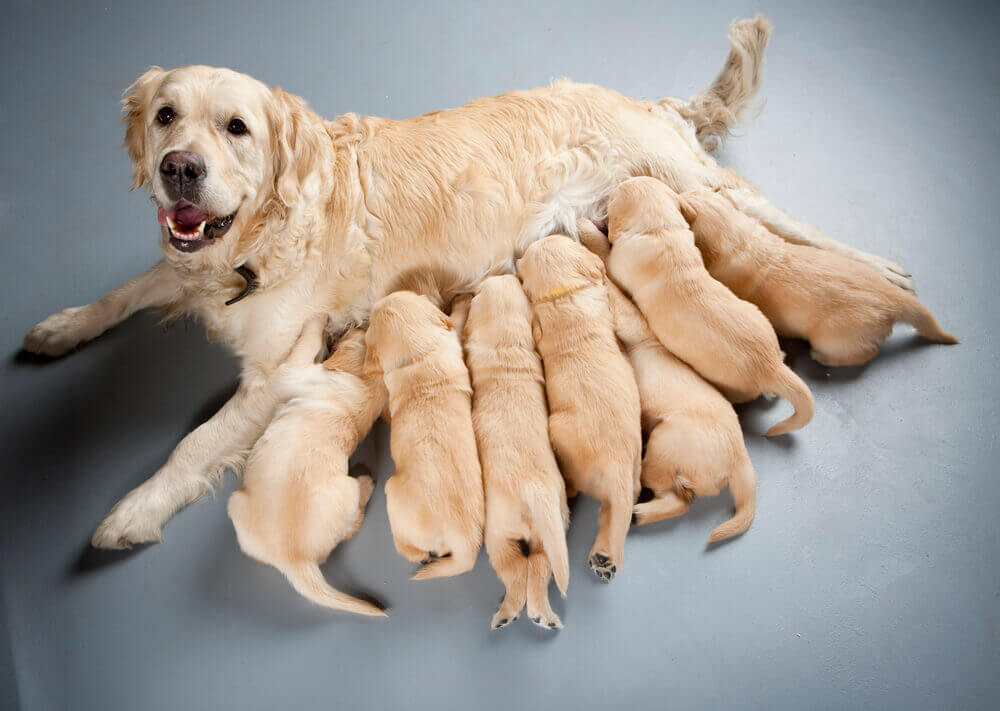
A Golden Retriever nursing her puppies
Caring for a Female Dog in Heat
While a female dog's heat is perfectly normal, it's also natural that as a pet parent you will want to keep her as safe and healthy as possible while also maintaining your own sanity, as dealing with a dog in heat can be stressful!
To help you achieve all of these things, here are some helpful tips.
Do Not Let Your Dog Walk Off Leash
Even the best trained female pup, who normally walks off leash like an angel, will be likely to make a run for it if they even think there is a male dog nearby when they are in active heat.
While your pup is in heat, ensure when she is walked it is using a strong leash, or strong leash and harness combination.
You may also want to avoid dog parks and other areas where lots of male dogs are around altogether during the estrus period, as that will save you the worry of trying to keep her under control.
Consider Using Doggy Diapers
Not only is the bleeding that accompanies active heat messy but the scent is also what attracts those roaming male dogs we discussed earlier.
If your dog is receptive to the idea you could try making use of doggie diapers, which are readily available, even for big dogs.
But, if she balks at wearing them don't force the issue, as that may further unbalance what is already a delicate mental state.
Let Her Rest If She Wants To
Some dogs get very lethargic when they are in heat, so may not want to stick to their regular exercise schedule. Again, if your pup seems to want to rest, let her rather than forcing the issue just because it's what you 'normally do'.
On the other hand, if she still seems up for her regular activities there is no harm in carrying on as normal, as long as you keep the tips we've already covered top of mind.
Consider Getting Her Spayed
Unless you specifically want to breed your pup, consider getting her spayed. According to many experts, doing so may not only prevent unwanted puppies, but it may be better for their health, especially when it comes to reproductive and mammary cancer prevention.

